Hotpoint AQS63F 29 EU Manual

Instructions for installation and use
WASHING MACHINE
EN |
|
PL |
|
RO |
|
|
|
|
|
|
|
English,1 |
Polski,13 |
Română,25 |
|||
Contents |
EN |
|
Installation, 2-3
Unpacking and levelling
Connecting the electricity and water supplies
Technical data
UK
Українська,37
AQUALTIS
AQS63F 29
Description of the machine, 4-5
Control panel
Running a wash cycle, 6
Wash cycles and options, 7
Table of wash cycles Wash options
Detergents and laundry, 8
Detergent
Preparing the laundry Washing recommendations Load balancing system
Precautions and advice, 9
General safety Disposal
Opening the porthole door manually
Care and maintenance, 10
Cutting off the water and electricity supplies Cleaning the machine
Cleaning the detergent dispenser drawer Caring for your appliance drum Cleaning the pump
Checking the water inlet hose
Trouble shooting, 11
Assistance, 12
1
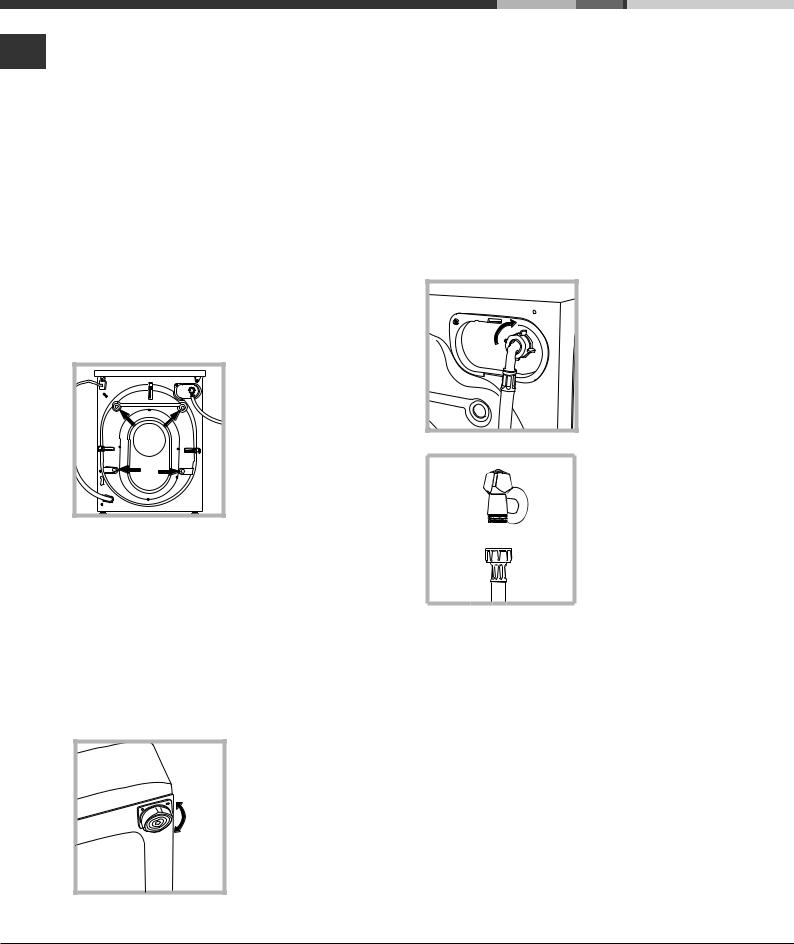
Installation
! This instruction manual should be kept in a safe place EN for future reference. If the washing machine is sold, given
away or moved, please ensure the manual is kept with the machine, so that the new owner may benefit from the advice contained within it.
!Read these instructions carefully: they contain vital information relating to the safe installation and operation of the appliance.
!Inside the pack containing this manual, you will also find the guarantee and all the details necessary for installation.
Unpacking and levelling
Unpacking
1. Once you have removed all the packaging from the washing machine, make sure it has not been damaged during transportation.
If it has been damaged, contact the retailer and do not proceed any further with the installation process.
2. Remove the 4 protective screws (used during transportation) and the corresponding spacer, located on the rear part of the appliance (see figure).
3.Close off the holes using the plastic plugs supplied in the pack.
4.Keep all the parts in a safe place; they will be needed again if the washing machine is moved to another location, to prevent the inside of the appliance being damaged.
! Packaging materials should not be used as toys for children.
Levelling
1. Place the washing machine on a flat sturdy floor, without resting it up against walls or cabinets.
2. If the floor is uneven, the front feet of the machine may be adjusted until
it reaches a horizontal position (the angle of inclination must not exceed 2 degrees).
!If the appliance is levelled correctly, it will be more stable and much less likely to cause vibrations and noise while it is operating, particularly during the spin cycle.
!If it is placed on carpet or a rug, adjust the feet in such a way as to allow a sufficient ventilation space underneath the washing machine.
Connecting the electricity and water supplies
Connecting the water inlet hose
! Before connecting the inlet hose to the water supply, run the water until it is perfectly clear.
1. Connect the inlet hose to the machine by screwing it onto the cold water inlet of the appliance, which is situated on the top righthand side of the rear part of the appliance (see figure).
2. Connect the inlet hose by screwing it to a cold water tap using a 3/4 gas threaded connection (see figure).
3. Make sure that the hose is not folded over or bent.
!The water pressure at the tap must fall within the values indicated in the Technical data table (see next page).
!If the inlet hose is not long enough, contact a specialised shop or an authorised technician.
!Never use second-hand or old inlet hoses; use the products supplied with the machine.
2
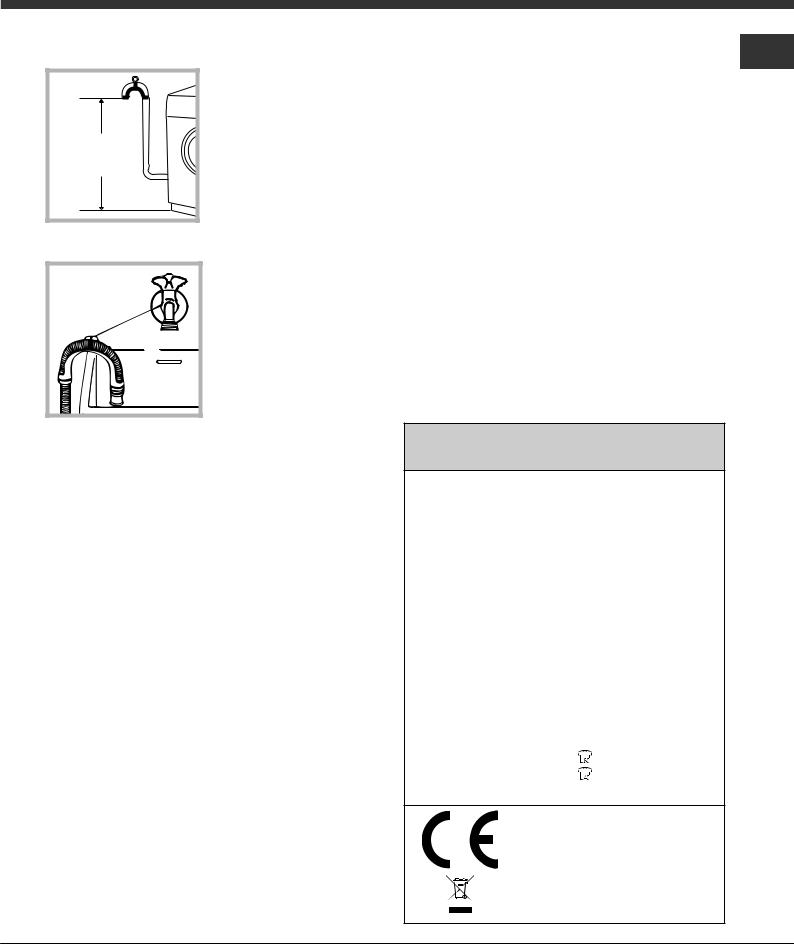
Connecting the drain hose
65 - 100 cm |
Connect the drain hose to drain duct piping or a wall drain located between 65 and 100 cm above the floor, making sure it is not bent at all.
Alternatively, rest the drain hose on the side of a washbasin or bathtub,
fastening the duct supplied to the tap (see figure).
The free end of the hose should not be underwater.
! Do not use extension cords or multiple sockets.
EN
!The cable should not be bent or compressed.
!The power supply cable and plug must only be replaced by authorised technicians.
Warning! The company shall not be held responsible in the event that these regulations are not respected.
! We advise against the use of hose extensions; if it is absolutely necessary, the extension must have the same diameter as the original hose and must not exceed 150 cm in length.
Electrical connections
Before plugging the appliance into the electricity socket, make sure that:
•the socket is earthed and complies with all applicable laws;
•the socket is able to withstand the maximum power load of the appliance as indicated in the Technical data table
(see opposite);
•the power supply voltage falls within the values indicated in the Technical data table (see opposite);
•the socket is compatible with the plug of the appliance.
If this is not the case, have the socket or the plug replaced.
!The appliace must only be installed indoor in a frost free and dry room, to prevent it from electronic damage due to frost or condensation.
!The mains socket must remain within easy reach after the washing machine has been installed.
Technical data
Model |
AQS63F 29 |
|
|
|
|
|
|
|
width 59.5 cm |
|
|
Dimensions |
height 85 cm |
|
|
|
depth 44,5 cm |
|
|
|
|
|
|
Capacity |
from 1 to 6 kg |
|
|
|
|
||
Electrical |
please refer to the technical data plate |
||
connections |
fixed to the machine |
||
|
|
||
|
maximum pressure 1 MPa (10 bar) |
||
Water connections |
minimum pressure 0.05 MPa (0.5 bar) |
||
|
drum capacity 48 litres |
||
|
|
||
Spin speed |
up to 1200 rotations per minute |
||
|
|
|
|
Test wash cycles |
|
|
|
in accordance |
programme |
; temperature 60°C; |
|
with directives |
|||
programme |
; temperature 40°C. |
||
1061/2010 and |
|||
|
|
||
1015/2010 |
|
|
|
This appliance conforms to the following
EC Directives:
-2004/108/EC (Electromagnetic Compatibility)
-2006/95/EC (Low Voltage)
- 2002/96/EC
3
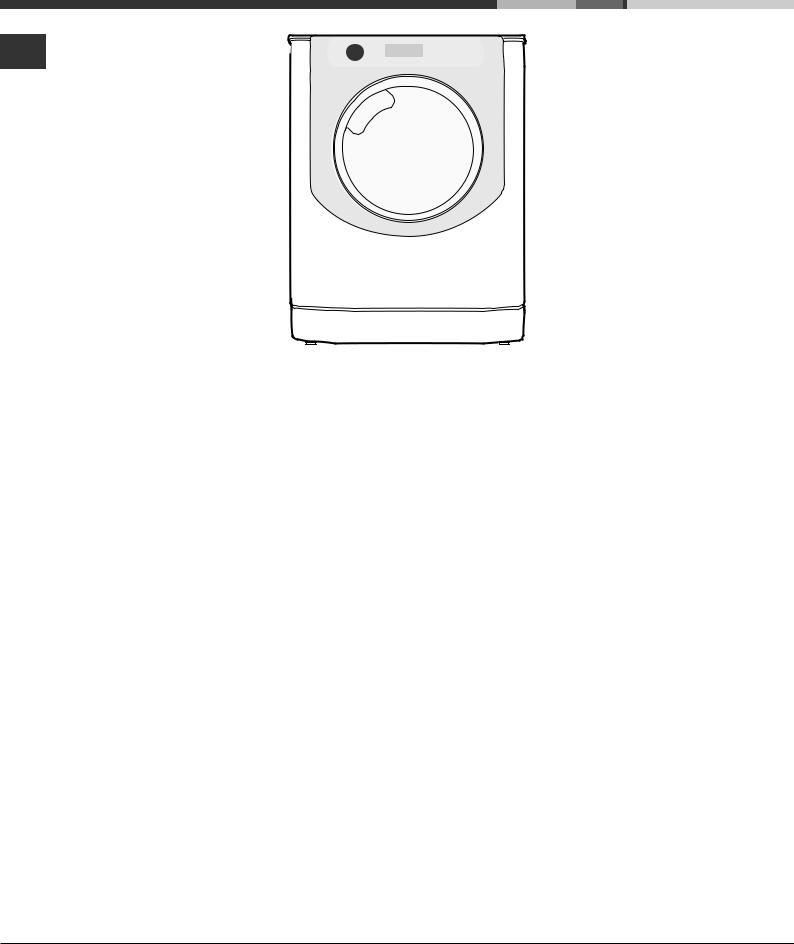
Description of the machine
EN |
|
CONTROL |
|
PORTHOLE DOOR |
PANEL |
|
|
PORTHOLE DOOR
HANDLE
KICK STRIP
ADJUSTABLE FEET
PORTHOLE DOOR
Always use the handle to open the porthole door (see figure).
DETERGENT DISPENSER DRAWER
The detergent dispenser drawer is located inside the machine and can be accessed by opening the door.
For more information on detergent measures, please refer to the chapter entitled
“Detergents and laundry”.
|
A |
|
1. pre-wash compartment: |
|
3 |
use powder detergent. |
|
|
|
! Before pouring in the |
|
|
|
|
|
|
|
1 |
detergent, make sure that |
B |
|
2 |
extra compartment 3 has |
|
been removed. |
||
|
|
|
|
|
|
|
2. main wash compartment: |
|
|
|
If liquid detergent is used, |
|
|
|
it is recommended that the |
|
|
|
removable plastic partition A |
|
|
|
(supplied) be used for proper |
dosage.If powder detergent is used, place the partition into slot B.
3. extra compartment: Bleach
! The use of extra compartment 3 excludes the prewash function.
 washing additives compartment: for fabric softener or liquid additives. We recommend that the maximum level indicated by the grille is not exceeded, and that concentrated fabric softeners are diluted.
washing additives compartment: for fabric softener or liquid additives. We recommend that the maximum level indicated by the grille is not exceeded, and that concentrated fabric softeners are diluted.
Standby mode
This washing machine, in compliance with new energy saving regulations, is fitted with an automatic standby system which is enabled after about 30 minutes if no activity is detected. Press the ON-OFF  button briefly and wait for the machine to start up again.
button briefly and wait for the machine to start up again.
Consumption in off-mode: 1 W Consumption in Left-on: 1 W
4

|
|
|
|
|
|
|
|
|
Control panel |
|
|
|
|
|
|
|
|
|
|
|
|
|
|
|
EN |
|
|
|
|
|
|
|
|
|
|
|
|
|
|
ECO |
|
WASH |
|
|
|
|
|
|
|
||||
|
|
|
|
indicator light |
|
CYCLE |
||
|
|
|
|
|
|
START/ |
PHASE |
|
|
|
|
|
|
|
|||
|
|
|
|
|
|
icons |
||
|
OPTION buttons |
OPTION buttons |
|
PAUSE |
||||
WASH CYCLE |
|
|
|
|||||
with indicator lights |
with indicator lights |
|
button with |
|
|
|||
|
|
|
|
|||||
SELECTOR knob |
|
|
|
|
|
indicator light |
|
|
|
|
|
|
|
|
|
||
|
|
|
|
|
|
|
|
|
|
|
|
|
|
|
|
|
|
|
|
|
|
|
|
|
|
|
DISPLAY
Button with ON/OFF |
TEMPERATURE button |
|
|
|
DELAYED |
|
|
CONTROL PANEL |
|
|
|
|
|
||||
indicator light |
|
|
|
START |
LOCK |
|
LOCK button with |
|
|
|
|
||||||
|
|
|
|
|
||||
|
SPIN button |
|
button |
indicator light |
indicator light |
|||
|
|
|
|
|
|
|||
Button with  ON/OFF indicator light: press this briefly to switch the machine on or off. The green indicator light
ON/OFF indicator light: press this briefly to switch the machine on or off. The green indicator light
indicates that the machine is switched on. To switch off the washing machine during the wash cycle, press and hold the button for approximately 3 seconds; if the button is pressed briefly or accidentally the machine will not switch off. If the machine is switched off during a wash cycle, this wash cycle will be cancelled.
WASH CYCLE SELECTOR knob: may be turned in either direction. To select the most suitable wash cycle, please refer to the “Table of wash cycles”.
The knob will not move during the wash cycle.
TEMPERATURE 
 button: press to modify or exclude the temperature setting; the value selected will appear on the display above (see “Running a wash cycle”).
button: press to modify or exclude the temperature setting; the value selected will appear on the display above (see “Running a wash cycle”).
SPIN CYCLE button: press to modify or exclude the spin cycle; the value selected will appear on the display above (see “Running a wash cycle”).
DELAYED START  button: press to set a delayed start for the selected wash cycle; the set delay time will appear on the display above (see “Running a wash cycle”).
button: press to set a delayed start for the selected wash cycle; the set delay time will appear on the display above (see “Running a wash cycle”).
OPTION buttons with indicator lights: press to select the available options. The indicator light corresponding to the selected option will remain lit (see “Running a wash cycle”).
WASH CYCLE PHASE icons: these illuminate to indicate the progress of the wash cycle (Wash  – Rinse
– Rinse  – Spin
– Spin  – Drain
– Drain  ). The text
). The text 

 lights up when the cycle is complete.
lights up when the cycle is complete.
START/PAUSE button with indicator light: when the green indicator light flashes slowly, press the button to start a wash cycle. Once the cycle has begun the indicator light will remain lit in a fixed manner. To pause the wash cycle, press the button again; the indicator light will flash in an orange colour. If the “LOCK”  indicator light is switched off, the door may be opened. To start the wash cycle from the point at which it was interrupted, press the button again.
indicator light is switched off, the door may be opened. To start the wash cycle from the point at which it was interrupted, press the button again.
LOCK  indicator light: indicates that the porthole door is locked. To open the door, pause the wash cycle (see “Running a wash cycle”).
indicator light: indicates that the porthole door is locked. To open the door, pause the wash cycle (see “Running a wash cycle”).
CONTROL PANEL LOCK  button with indicator light: to activate or deactivate the control panel lock, press and hold the button for approximately 2 seconds. when the indicator light is illuminated, the control panel is locked. This means it is possible to prevent wash cycles from being modified accidentally, especially where there are children in the home.
button with indicator light: to activate or deactivate the control panel lock, press and hold the button for approximately 2 seconds. when the indicator light is illuminated, the control panel is locked. This means it is possible to prevent wash cycles from being modified accidentally, especially where there are children in the home.
ECO indicator light: the 

 icon lights up when, after altering the washing parameters, an energy saving of at least 10% is made. Furthermore, before the machine enters “Standby” mode, the icon will light up for a few
icon lights up when, after altering the washing parameters, an energy saving of at least 10% is made. Furthermore, before the machine enters “Standby” mode, the icon will light up for a few
seconds; when the machine is switched off the estimated energy saving will be around the 80% mark.
5

Running a wash cycle
WARNING: before you use the washing machine for the EN first time, run a wash cycle with detergent and no laundry,
using the 90° cottons cycle without pre-wash.
1.SWITCH THE MACHINE ON. Press the  button. All the indicator lights will illuminate for 1 second; the indicator light corresponding to the
button. All the indicator lights will illuminate for 1 second; the indicator light corresponding to the  button will then remain lit in a fixed manner and the START/PAUSE indicator light will flash slowly.
button will then remain lit in a fixed manner and the START/PAUSE indicator light will flash slowly.
2.LOAD THE LAUNDRY. Open the porthole door. Load the laundry, making sure you do not exceed the maximum load value indicated in the table of wash cycles on the following page.
3.MEASURE OUT THE DETERGENT. Pull out the detergent dispenser drawer and pour the detergent into the relevant compartments as described in “Description of the machine”.
4.CLOSE THE PORTHOLE DOOR.
5.SELECT THE PROGRAMME. Turn the WASH CYCLE SELECTOR KNOB right or left, until you have selected the desired wash cycle. A temperature and spin speed is set for each wash cycle; these may be adjusted.
6.CUSTOMISE THE WASH CYCLE. Use the relevant buttons on the control panel:
Modify the temperature and/or spin speed.
The machine automatically displays the maximum temperature and spin speed values set for the selected cycle, or the most recently-used settings if they are compatible with the selected cycle. The temperature can be decreased by pressing the 
 button, until the cold wash (
button, until the cold wash (
 ) setting is reached. The spin speed may be progressively reduced by pressing the button, until it is completely excluded (
) setting is reached. The spin speed may be progressively reduced by pressing the button, until it is completely excluded (
 ). If these buttons are pressed again, the maximum values are restored.
). If these buttons are pressed again, the maximum values are restored.
! Exception: if the  programme is selected, the temperature can be increased up to a value of 90°C.
programme is selected, the temperature can be increased up to a value of 90°C.
 Set a delayed start.
Set a delayed start.
Press the button until you have reached the desired delay time. During the setting process, the delay time is shown on the display and the  symbol flashes.
symbol flashes.
After selecting a delayed start time, the fixed  symbol and the cycle duration will appear on the display. Press the button once to display the selected delay time.
symbol and the cycle duration will appear on the display. Press the button once to display the selected delay time.
To remove the delayed start option, press the button until the display shows the text OFF; the 

 symbol will disappear.
symbol will disappear. 
! Once the START/PAUSE button has been pressed, the time delay may only be decreased.



 Modify the cycle settings.
Modify the cycle settings.
Press the OPTION buttons to customise the wash cycle in accordance with your own requirements.
•Press the button to activate the option; the corresponding indicator light will switch on.
•Press the button again to disable the option; the indicator light will switch off.
!If the selected option is not compatible with the selected wash cycle, this incompatibility will be signalled by the flashing of the indicator light and a sound alert
(3 beeps); the option will not be activated.
!If the selected option is not compatible with another option that has been selected previously, the indicator light corresponding to the first option selected will flash and only the second option will be activated; the indicator light corresponding to the button will remain lit in a constant manner.
7.START THE PROGRAMME. Press the START/PAUSE button. The corresponding indicator light remains lit in a
fixed manner and the porthole door locks (the  LOCK indicator light illuminates). The icons corresponding to the wash cycle phases will light up during the cycle to indicate which phase is currently in progress.
LOCK indicator light illuminates). The icons corresponding to the wash cycle phases will light up during the cycle to indicate which phase is currently in progress.
To change a wash cycle once it has already started, pause the washing machine by pressing the START/ PAUSE button; then select the desired cycle and press the START/PAUSE button again.
To open the door during a wash cycle, press the START/
PAUSE button; if the LOCK  indicator light is switched off you may open the door. Press the START/PAUSE button again to restart the wash cycle from the point at which it was interrupted.
indicator light is switched off you may open the door. Press the START/PAUSE button again to restart the wash cycle from the point at which it was interrupted.
8.THE END OF THE WASH CYCLE. This is indicated by the illuminated text END. The porthole door may be opened immediately. If the START/PAUSE indicator light is flashing, press the button to end the cycle. Open the door, unload the laundry and switch off the machine.
! If you wish to cancel a cycle which has already begun, press and hold the  button until the cycle stops and the machine switches off.
button until the cycle stops and the machine switches off.
6
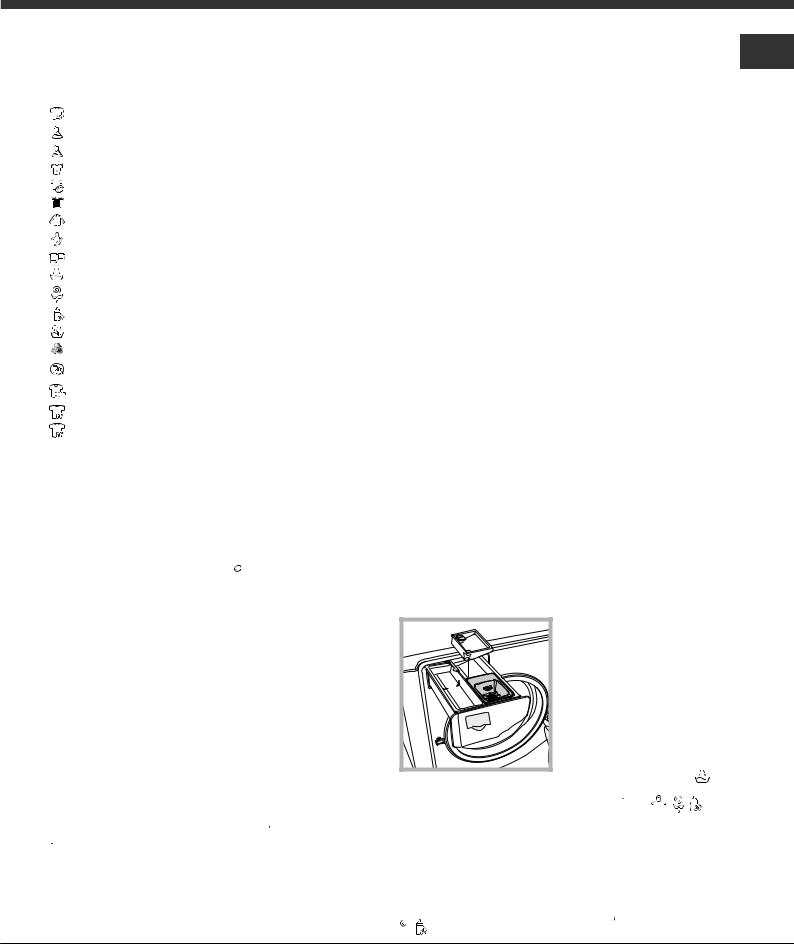
Wash cycles and options
Table of wash cycles
|
|
|
|
Prewash |
Detergent and |
loadMax.(kg) |
Residualdampness% |
EnergyconsumptionkWh |
waterTotal lt |
Cycleduration |
|||
|
|
|
|
|
Wash |
Bleach |
Fabric softener |
||||||
|
|
Max. |
|
|
|
additives |
|
|
|
|
|
|
|
|
|
Max. spe- |
|
|
|
|
|
|
|
|
|
|
|
Icon |
Description of the wash cycle |
temp. |
ed (rpm) |
|
|
|
|
|
|
|
|
|
|
|
|
(°C) |
|
|
|
|
|
|
|
|
|
|
|
|
|
|
|
|
|
|
|
|
|
|
|
|
|
|
Cotton (2-3): lightly soiled whites and delicate colours. |
40° |
1200 |
- |
|
|
|
|
6 |
53 |
0,85 |
66 |
150’ |
|
|
|
|
|
|
|
|
|
|
|
|
|
|
|
Synthetics Resistant |
60° |
800 |
- |
|
|
|
|
3 |
49 |
0,87 |
42 |
90’ |
|
|
|
|
|
|
|
|
|
|
|
|
|
|
|
Synthetics Resistant (5) |
40° |
800 |
- |
|
|
|
|
3 |
49 |
0,56 |
42 |
80’ |
|
|
|
|
|
|
|
|
|
|
|
|
|
|
|
Whites |
60° |
1200 |
- |
|
|
- |
|
4 |
- |
- |
- |
190’ |
|
Coloureds (4) |
40° |
1200 |
- |
|
|
|
|
4 |
53 |
0,79 |
75 |
90’ |
|
Darks |
30° |
800 |
- |
|
|
- |
|
4 |
- |
- |
- |
80’ |
|
Shirts |
40° |
600 |
- |
|
|
|
|
2 |
- |
- |
- |
85’ |
|
Quilted Jacket: to wash clothes padded with goose down (such as puffa |
30° |
1000 |
- |
|
|
- |
|
1,5 |
- |
- |
- |
130’ |
|
jackets) or cushions. |
|
|||||||||||
|
|
|
|
|
|
|
|
|
|
|
|
|
|
|
Bed&Bath for bedlinen and towels. |
60° |
1200 |
- |
|
|
|
|
6 |
- |
- |
- |
135’ |
|
Rinse |
- |
1200 |
- |
|
- |
|
|
6 |
- |
- |
- |
49’ |
|
|
|
|
|
|
|
|
|
|
|
|
|
|
|
Spin and Pump out |
- |
1200 |
- |
|
- |
- |
- |
6 |
- |
- |
- |
16’ |
|
|
|
|
|
|
|
|
|
|
|
|
|
|
|
Anti allergy |
60° |
1200 |
- |
|
|
- |
|
4 |
- |
- |
- |
200’ |
|
|
|
|
|
|
|
|
|
|
|
|
|
|
|
Ultradelicates |
30° |
0 |
- |
|
|
- |
|
1 |
- |
- |
- |
75’ |
|
|
|
|
|
|
|
|
|
|
|
|
|
|
|
Wool: for wool, cashmere, etc. |
40° |
800 |
- |
|
|
- |
|
1,5 |
- |
- |
- |
80’ |
|
|
|
|
|
|
|
|
|
|
|
|
|
|
|
Mix 30': to refresh lightly soiled garments quickly (not suitable for wool, silk and |
30° |
800 |
- |
|
|
- |
|
3 |
71 |
0,19 |
39 |
30’ |
|
clothes which require washing by hand). |
|
|||||||||||
|
|
|
|
|
|
|
|
|
|
|
|
|
|
|
Cotton Prewash |
90° |
1200 |
|
|
|
- |
|
6 |
53 |
2,21 |
93 |
180’ |
|
(Add detergent to the relevant compartment). |
|
|||||||||||
|
|
|
|
|
|
|
|
|
|
|
|
|
|
|
Cotton (1): heavily soiled whites and resistant colours. |
60° |
1200 |
- |
|
|
|
|
6 |
53 |
0,84 |
55 |
160’ |
|
|
|
|
|
|
|
|
|
|
|
|
|
|
|
Cotton: heavily soiled whites and resistant colours. |
90° |
1200 |
- |
|
|
|
|
6 |
53 |
1,93 |
84 |
165’ |
|
|
|
|
|
|
|
|
|
|
|
|
|
|
The length of cycle shown on the display or in this booklet is an estimation only and is calculated assuming standard working conditions. The actual duration can vary according to factors such as water temperature and pressure, the amount of detergent used, the amount and type of load inserted, load balancing and any wash options selected.
(*) Note: 10 minutes after the START, the machine will recalculate the time remaining until the end of the wash cycle on the basis of the load inside it; this value will then be shown on the display.
For all Test Institutes:
1) Test wash cycle in compliance with directive 1061/2010: set wash cycle  with a temperature of 60°C.
with a temperature of 60°C.
This cycle is designed for cotton loads with a normal soil level and is the most efficient in terms of both electricity and water consumption; it should be used for garments which can be washed at 60°C. The actual washing temperature may differ from the indicated value.
2) Test wash cycle in compliance with directive 1061/2010: set wash cycle  with a temperature of 40°C.
with a temperature of 40°C.
This cycle is designed for cotton loads with a normal soil level and is the most efficient in terms of both electricity and water consumption; it should be used for garments which can be washed at 40°C. The actual washing temperature may differ from the indicated value.
3) Long wash cycle for cottons: set wash cycle  with a temperature of 40°C. 4) Short wash cycle for cottons: set wash cycle
with a temperature of 40°C. 4) Short wash cycle for cottons: set wash cycle  with a temperature of 40°C. 5) Long wash cycle for synthetics: set wash cycle
with a temperature of 40°C. 5) Long wash cycle for synthetics: set wash cycle with a temperature of 40°C.
with a temperature of 40°C.
Wash options
 Extra rinse
Extra rinse
By selecting this option, the efficiency of the rinse is increased and optimal residual detergent removal is guaranteed. It is particularly useful for skin which is sensitive to detergents. We recommend this option is used with a full load of washing, or when a large amount of detergent is required.
! It cannot be used in conjunction with  ,
,  ,
,  ,
,  ,
,  .
.
 Easy Iron
Easy Iron
By selecting this option, the wash and spin cycles will be modified in order to reduce the formation of creases.
At the end of the cycle the washing machine drum will rotate slowly; the “Easy Iron” and START/PAUSE indicator lights will flash. To end the cycle press the START/PAUSE button or the “Easy Iron” button.
! It cannot be used in conjunction with  ,
,  ,
,  ,
,  ,
,  .
.
 Super Wash
Super Wash
This option offers a high-performance wash due to the greater quantity of water used in the initial phase of the cycle, and due to the increased wash cycle duration, is particularly useful for the removal of stubborn stains. It can be used with or without bleach.
|
|
If you desire bleaching, insert |
|
3 |
the extra tray compartment |
|
(3) into compartment 1. |
|
|
|
|
|
1 |
When pouring in the bleach, |
|
be careful not to exceed the |
|
|
|
|
2 |
|
“max” level marked on the |
|
|
central pivot (see figure). To |
|
|
bleach laundry without |
|
|
carrying out a full wash |
|
|
cycle, pour the bleach into |
|
|
the extra compartment 3, |
|
|
select the “Rinse” cycle” |
and activate the “Super Wash” option  .
.
! It cannot be used in conjunction with  ,
,  ,
,  , , ,
, , ,  ,
,  ,
,  ,
,  .
.
 Time Saver
Time Saver
If you select this option, the wash cycle duration will be reduced by up to 50%, depending on the selected cycle, thereby guaranteeing simultaneous water and energy saving. Use this cycle for lightly soiled garments.
! It cannot be used in conjunction with  ,
,  ,
,  ,
,  ,
,  ,
,
 , ,
, ,  ,
,  .
.
EN
7

Detergents and laundry
EN |
Detergent |
|
The type and quantity of detergent required depend on |
||
|
||
|
the type of fabric you are washing (cotton, wool, silk, |
|
|
etc.), as well as its colour, the washing temperature, the |
|
|
level of soiling and the hardness of the water in the area. |
|
|
Measuring out the detergent carefully will avoid wastage |
|
|
and help to protect the environment: although they are |
|
|
biodegradable, detergents still contain ingredients which |
|
|
alter the balance of nature. |
|
|
We recommend the following: |
|
|
• use powder detergents for white cotton garments and |
|
|
pre-washing. |
|
|
• use liquid detergents for delicate cotton garments and |
|
|
for all low-temperature wash cycles. |
|
|
• use gentle liquid detergents for wool and silk |
|
|
garments. |
|
|
The detergent should be poured into the relevant |
|
|
compartment - or the dispenser placed directly inside the |
|
|
drum - before the wash cycle begins. In the latter case, it will |
|
|
not be possible to select the Cottons with pre-wash cycle. |
|
|
! Use powder detergent for white cotton garments, for |
|
|
pre-washing, and for washing at temperatures over 60°C |
|
|
! Follow the instructions given on the detergent packaging. |
|
|
! Do not use hand washing detergents because these |
|
|
create too much foam. |
Preparing the laundry
•Shake out the garments before loading them into the machine.
•Divide the laundry according fabric type (symbol on the washing instruction label) and colour, making sure you separate the coloured garments from the white ones;
•Empty all pockets and check the buttons;
•Do not exceed the values listed in the “Table of wash cycles”, which refer to the weight of the laundry when dry.
How much does your laundry weigh?
1 sheet |
400-500 g |
1 pillowcase |
150-200 g |
1 tablecloth |
400-500 g |
1 bathrobe |
900-1200 g |
1 towel |
150-250 g |
1 pair of jeans |
400-500 g |
1 shirt |
150-200 g |
Washing recommendations
Whites: use this cycle  to wash white clothes. The programme is designed to maintain the brightness of white clothes over time.
to wash white clothes. The programme is designed to maintain the brightness of white clothes over time.
Coloureds: use this cycle  to wash bright coloured clothes. The programme is designed to maintain bright colours over time.
to wash bright coloured clothes. The programme is designed to maintain bright colours over time.
Darks: Use cycle  to wash dark-coloured garments. This programme is designed to maintain dark colours over time. We recommend using a liquid detergent for the best results when washing dark-coloured garments. Shirts: use the special
to wash dark-coloured garments. This programme is designed to maintain dark colours over time. We recommend using a liquid detergent for the best results when washing dark-coloured garments. Shirts: use the special  wash cycle to wash shirts in different fabrics and colours to guarantee they receive the best possible care.
wash cycle to wash shirts in different fabrics and colours to guarantee they receive the best possible care.
Quilted Jacket: to wash quilted jacket, cushions or clothes padded with goose down (the weight of which
should not exceed 1,5 kg), use the special |
wash cycle. |
Bedlinen and towels: use programme |
to wash bed |
linen and towels in one single cycle: it optimises softener performance and helps you save time and energy. We recommend the use of powder detergent
Anti Allergy: use programme  to remove major allergens such as pollen, mites, cat’s and dog’s hair. Ultradelicates: use programme
to remove major allergens such as pollen, mites, cat’s and dog’s hair. Ultradelicates: use programme  to wash very delicate garments having strasses or sequins.
to wash very delicate garments having strasses or sequins.
We recommend turning the garments inside out before washing and placing small items into the special bag for washing delicates. Use liquid detergent on delicate garments for best results.
To wash Silk garments and Curtains select cycle  and
and
then option |
; the machine will end the cycle while the |
|
laundry is soaking and the |
indicator light will flash. To |
|
drain the water so that the laundry may be removed, press the START/PAUSE button or the  button.
button.
Wool: the wool wash cycle on this Hotpoint-Ariston machine has been tested and approved by The Woolmark Company for washing wool garments labelled as hand washable provided that the garments are washed according to the instructions on the garment label
and those issued by the manufacturer of this washing machine. Hotpoint-Ariston is the first washing machine brand to be approved by The Woolmark Company for Apparel CarePlatinum for its washing performance and consumption of energy and water. 


Stubborn stains: it is wise to treat stubborn stains with solid soap before washing, and to use the Cottons with pre-wash cycle.
Load balancing system
Before every spin cycle, to avoid excessive vibrations before every spin and to distribute the load in a uniform manner, the drum rotates continuously at a speed which is slightly greater than the washing rotation speed. If, after several attempts, the load is not balanced correctly, the machine spins at a reduced spin speed. If the load is excessively unbalanced, the washing machine performs the distribution process instead of spinning. To encourage improved load distribution and balance, we recommend small and large garments are mixed in the load.
8
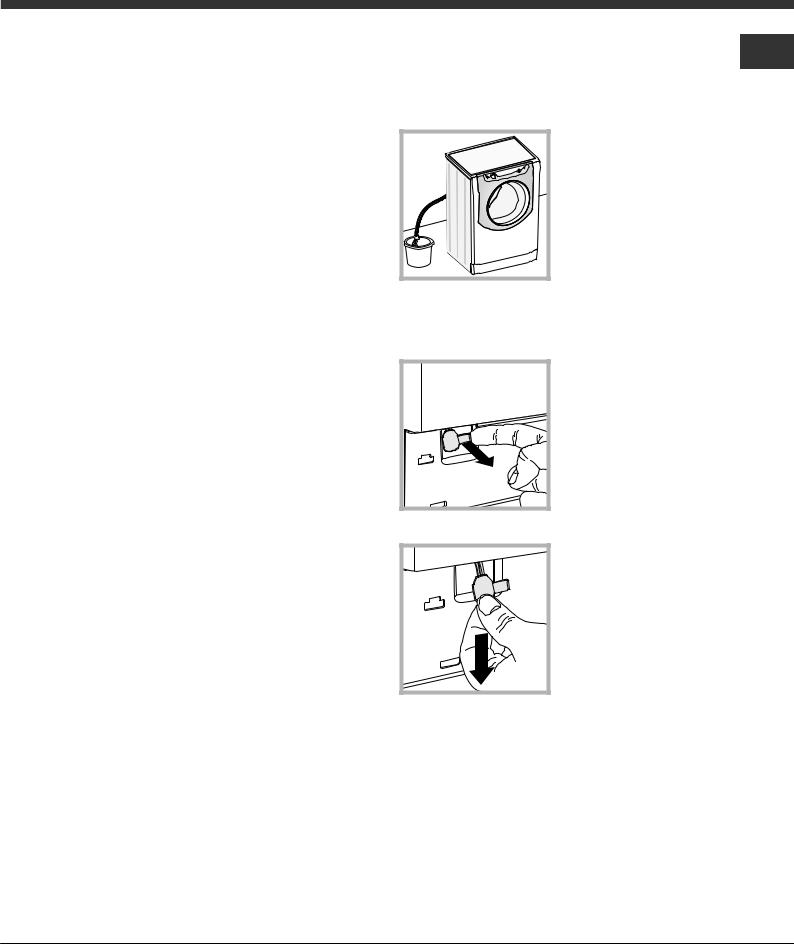
Precautions and tips
! The machine was designed and constructed in accordance with international safety regulations. The following information is provided for safety reasons and must therefore be read carefully.
General safety
•This appliance was designed for domestic use only.
•This appliance is not intended for use by persons
(including children) with reduced physical, sensory or mental capabilities, or lack of experience and knowledge, unless they have been given supervision or instruction concerning use of the appliance by a person responsible for their safety. Children should be supervised to ensure that they do not play with the appliance.
•the machine must only be used by adults, in accordance with the instructions given in this manual.
•Do not touch the machine when barefoot or with wet or damp hands or feet.
•Do not pull on the power supply cable when unplugging the appliance from the electricity socket. Hold the plug and pull.
•Do not touch the drained water as it may reach extremely high temperatures.
•Never force the porthole door. This could damage the safety lock mechanism designed to prevent accidental opening.
•If the appliance breaks down, do not under any circumstances access the internal mechanisms in an attempt to repair it yourself.
•Always keep children well away from the appliance while it is operating.
•If it must be moved, proceed with the help of two or three people and handle it with the utmost care. Never try to do this alone, because the appliance is very heavy.
•Before loading laundry into the washing machine, make sure the drum is empty.
Disposal
•Disposing of the packaging materials: observe local regulations so that the packaging may be re-used.
•The European Directive 2002/96/EC relating to Waste
Electrical and Electronic Equipment (WEEE) states that household appliances should not be disposed of using the normal solid urban waste cycle. Exhausted appliances should be collected separately in order to
optimise the cost of re-using and recycling the materials inside the machine, while preventing potential damage to the atmosphere and to public health. The crossed-out dustbin is marked on all products to remind the owner of their obligations regarding separated waste collection. For more information relating to the correct disposal of household appliances, owners should contact their local authorities or appliance dealer.
Opening the porthole door manually |
EN |
|
In the event that it is not possible to open the porthole door due to a powercut, and if you wish to remove the laundry, proceed as follows:
1. remove the plug from the electrical socket.
2. make sure the water level inside the machine is lower than the door opening; if
it is not, remove excess water using the drain hose, collecting it in a bucket as indicated in the figure.
3. remove the cover panel on the lower front part of the washing machine (see overleaf).
4. pull outwards using the tab as indicated in the figure, until the plastic tie-rod is freed from its stop position; pull downwards until you hear a “click”, which indicates that the door is now unlocked.
5. open the door; if this is still not possible repeat the procedure.
6. reposition the panel, making sure the hooks are securely in place before you push it onto the appliance.
9
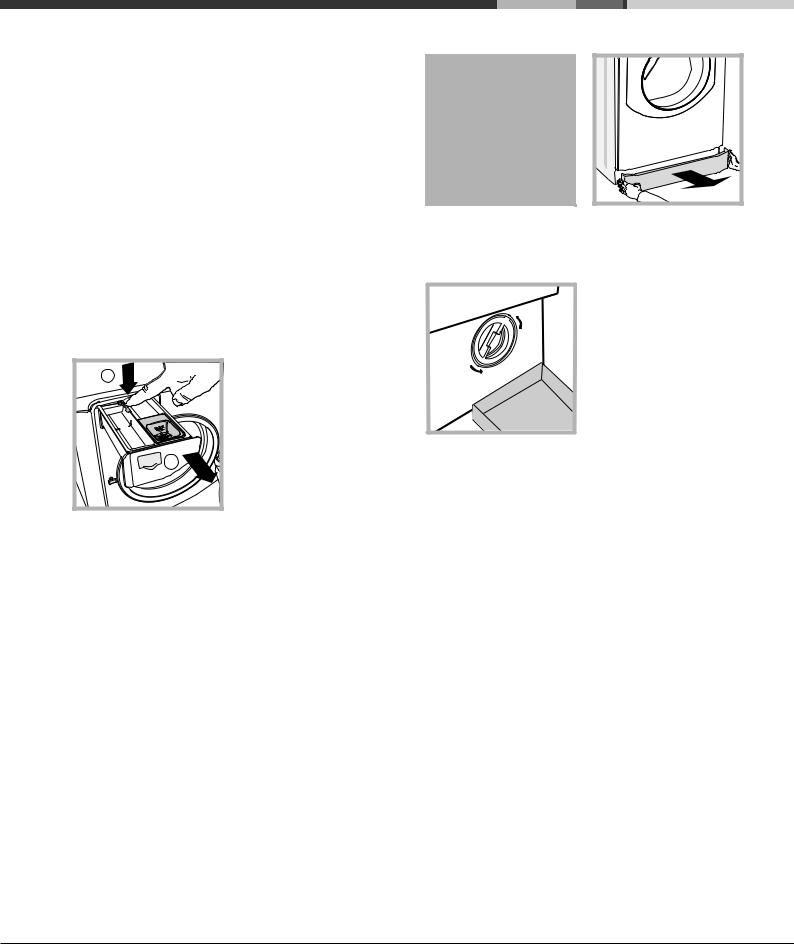
Care and maintenance
|
Cutting off the water and electricity |
|
EN |
||
supplies |
||
|
||
|
• Turn off the water tap after every wash cycle. This will |
|
|
limit wear on the hydraulic system in the machine and |
|
|
help to prevent leaks. |
|
|
• Unplug the appliance when cleaning it and during all |
|
|
maintenance work. |
|
|
Cleaning the machine |
|
|
The outer parts and rubber components of the appliance |
|
|
can be cleaned using a soft cloth soaked in lukewarm |
|
|
soapy water. Do not use solvents or abrasives. |
|
|
Cleaning the detergent dispenser |
|
|
drawer |
1 |
1 |
2 |
2 |
To remove the drawer, press lever (1) and pull the drawer outwards (2) (see figure).
Wash it under running water; this procedure should be repeated frequently.
To access the pre-chamber:
1. take off the cover panel on the front of the machine by first pressing it in the centre and then pushing downwards on both sides until you can remove it (see figures);
2. position a container so that it will collect the water which flows out (approximately 1.5 l) (see figure);
3. unscrew the lid by rotating it in an anti-clockwise direction (see figure);
4.clean the inside thoroughly;
5.screw the lid back on;
6.reposition the panel, making sure the hooks are securely in place before you push it onto the appliance.
Caring for your appliance drum
•Always leave the door ajar to prevent unpleasant odours from forming.
Cleaning the pump
The washing machine is fitted with a self-cleaning pump which does not require any maintenance. Sometimes, small items (such as coins or buttons) may fall into the protective pre-chamber at the base of the pump.
Make sure the wash cycle has finished and unplug the appliance.
Checking the water inlet hose
Check the inlet hose at least once a year. If there are any cracks, it should be replaced immediately: during the wash cycles, water pressure is very strong and a cracked hose could easily split open.
10

Trouble shooting
Your washing machine could occasionally fail to work. Before contacting the Technical Assistance Centre (see “Assistance”), |
EN |
make sure that the problem cannot be not solved easily using the following list. |
Problem:
The washing machine does not switch on.
Possible causes / Solutions:
•The appliance is not plugged into the socket fully, or not enough to make contact.
•There is no power in the house.
The wash cycle does not start.
•The door is not closed properly.
•The START/PAUSE button has not been pressed.
•The water tap has not been opened.
•A delayed start has been set.
The washing machine does not fill with water.
The washing machine door remains locked.
The machine continuously fills with water and drains.
•The water inlet hose is not connected to the tap.
•The hose is bent.
•The water tap has not been opened.
•There is no water supply in the house.
•The pressure is too low.
•The START/PAUSE button has not been pressed.
•If you have selected the  option, at the end of the cycle the washing machine drum will rotate slowly; to end the cycle press the START/PAUSE button or the
option, at the end of the cycle the washing machine drum will rotate slowly; to end the cycle press the START/PAUSE button or the  option.
option.
•The drain hose is not fitted at a height between 65 and 100 cm from the floor
(see “Installation”).
•The free end of the hose is under water (see “Installation”).
•If the dwelling is on one of the upper floors of a building, there may be problems relating to water drainage, causing the washing machine to fill with water and drain continuously. Special anti-draining valves are available in shops and help to prevent this inconvenience.
•The wall drainage system is not fitted with a breather pipe.
The washing machine does not drain or spin.
•The wash cycle does not include draining: Some wash cycles require the drain phase to be started manually (see “Wash cycles and options”).
•The “Easy iron” option is enabled: to complete the wash cycle, press the
START/PAUSE button (“Wash cycles and options”).
•The drain hose is bent (see Installation).
•The drainage duct is clogged.
The machine vibrates a lot during the spin cycle.
The washing machine leaks.
•The drum was not unlocked correctly during installation (see “Installation”).
•The machine is not level (see “Installation” ).
•The machine is trapped between cabinets and walls (see “Installation”).
•The load is unbalanced (see “Detergents and laundry”).
•The water inlet hose is not screwed on properly (see “Installation”).
•The detergent dispenser is blocked (to clean it, see “Care and maintenance”).
•The drain hose is not fixed in place properly (see “Installation”).
The icons corresponding to the “Phase in progress” flash rapidly at the same time as the ON/OFF indicator light.
•Switch off the machine and unplug it, wait for approximately 1 minute and then switch it back on again. If the problem persists, contact the Technical Assistance Service.
There is too much foam.
The washing machine door remains locked.
•The detergent is not suitable for machine washing (it should display the text
“for washing machines” or “hand and machine wash”, or the like).
•Too much detergent was used.
•Perform the manual unlocking procedure (see “Precautions and tips”).
! Note: to exit “Demo mode”, switch machine off, then press and hold the two “START/PAUSE” 
 and “ON/OFF”
and “ON/OFF”  buttons simultaneously for 3 seconds.
buttons simultaneously for 3 seconds.
11

Assistance
|
|
|
|
|
|
|
|
Before calling for Assistance: |
|
||||
EN |
|
|||||
• Check whether you can solve the problem by yourself (see “Trouble shooting”); |
|
|||||
|
|
|||||
|
• Restart the wash cycle to check whether the problem has been solved; |
|
||||
|
|
|||||
|
• If it has not, contact the Authorised Technical Assistance Service. |
|
||||
|
! If the washing machine has been installed or used incorrectly, you will have to pay for the call-out service. |
|
||||
|
! Always request the assistance of authorised technicians. |
|
||||
Please have the following information to hand:
•the type of problem;
•the appliance model (Mod.);
•the serial number (S/N).
The above information can be found on the data plate located on the appliance itself.
12

Instrukcja instalacji i obsługi
PRALKA
|
|
|
|
|
|
|
|
Spis treści |
|
|
|
|
PL |
|
|
|
|
Instalacja, 14-15 |
|
|
|
|
|
|
|
PL |
|
|
|
|
|
Rozpakowanie i wypoziomowanie |
|
|
|
|
|
Podłączenia hydrauliczne i elektryczne |
|
|
|
|
|
|
|
Polski |
Dane techniczne |
|
|
|
|
|
Opis urządzenia, 16-17 |
|
|
|
|
Pulpit sterowania |
|
|
|
|
Jak wykonać cykl prania, 18 |
|
|
|
|
Programy i opcje, 19 |
|
|
|
|
Tabela programów |
|
|
|
|
Opcje |
|
AQUALTIS
AQS63F 29
Środki piorące i bielizna, 20
Środek piorący Przygotowanie bielizny Zalecenia dotyczące prania System równoważenia ładunku
Zalecenia i środki ostrożności, 21
Ogólne zasady bezpieczeństwa Utylizacja
Ręczne otwieranie drzwiczek
Utrzymanie i konserwacja, 22
Odłączenie wody i prądu elektrycznego Czyszczenie maszyny
Czyszczenie szufladki na środki piorące Czyszczenie bębna
Czyszczenie pompy
Kontrola przewodu doprowadzającego wodę
Nieprawidłowości w działaniu i sposoby ich usuwania, 23
Serwis Techniczny, 24
13
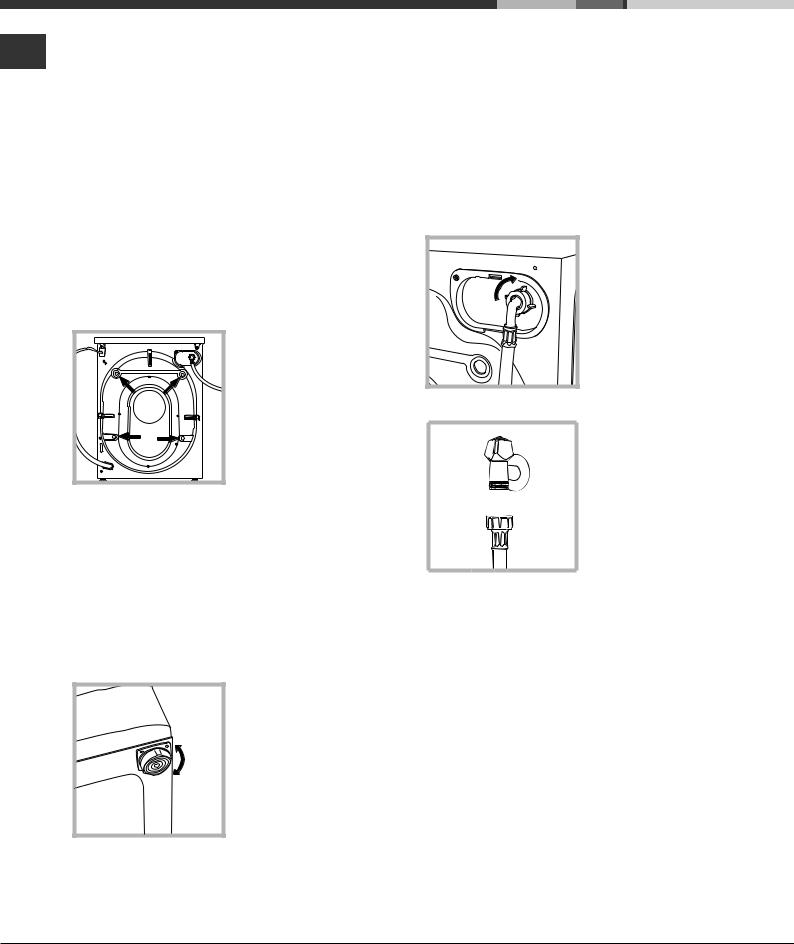
Instalacja
PL |
! Należy zachować niniejszą książeczkę, aby móc z niej |
|
skorzystać w każdej chwili. W przypadku sprzedaży, |
||
|
||
|
odstąpienia lub przeprowadzki należy upewnić się, że |
|
|
pozostanie razem z pralką. |
|
|
! Należy uważnie przeczytać instrukcję obsługi: |
|
|
zawiera ona ważne informacje dotyczące instalacji oraz |
|
|
właściwego i bezpiecznego użytkowania pralki. |
|
|
!W kopercie zawierającej niniejszą instrukcję, oprócz |
|
|
gwarancji, znajdują się detale pomagające przy instalacji. |
|
|
Rozpakowanie i wypoziomowanie |
|
|
Rozpakowanie |
|
|
1. Po wypakowaniu pralki upewnić się, że nie doznała |
|
|
uszkodzeń podczas transportu. |
|
|
W przypadku stwierdzenia uszkodzeń nie podłączać jej i |
|
|
skontaktować się ze sprzedawcą. |
|
|
2. Odkręcić 4 śruby |
|
|
ochronne umocowane |
|
|
na czas transportu oraz |
|
|
odpowiednią rozpórkę, |
|
|
znajdujące się w części |
|
|
tylnej (patrz rysunek). |
3.Zatkać otwory przy pomocy plastikowych korków znajdujących się w kopercie.
4.Przechowywać wszystkie części; jeśli pralka będzie przenoszona, powinny zostać ponownie zamontowane uszkodzeń celu uniknięcia uszkodzeń wewnętrznych. ! Części opakowania nie są zabawkami dla dzieci.
Poziomowanie
1. Ustawić pralkę na płaskiej i twardej podłodze; nie opierać jej o ściany lub meble.
2. Skompensować nierówności odkręcając lub przykręcając nóżki aż urządzenie znajdzie się w położeniu poziomym (jego nachylenie nie powinno przekraczać 2 stopnii).
! Dokładne wypoziomowanie powoduje, że urządzenie jest stabilne i umożliwia wyeliminowanie drgań i hałasów, zwłaszcza podczas fazy wirowania.
! W razie ustawienia na dywanie lub wykładzinie dywanowej należy tak wyregulować nóżki, aby pod pralką pozostawała wolna przestrzeń niezbędna dla wentylacji.
Podłączenia hydrauliczne i elektryczne
Podłączenie rury pobierania wody
! Przed podłączeniem przewodu zasilającego do sieci wodociągowej spuścić wodę aż do pojawienia się przejrzystej wody.
1. Podłączyć do urządzenia przewód doprowadzający wodę, przykręcając
go do odpowiedniego otworu dopływowego, znajdującego się w tylnej części pralki, z prawej strony u góry (patrz rysunek)..
2. Podłączyć przewód zasilający poprzez przykręcenie go do zaworu wody zimnej z otworem
z gwintem rurowym drobnozwojowym ¾ (patrz rysunek).
3. Zwrócić uwagę, aby na przewodzie nie było zagięć ani zwężeń.
!Ciśnienie wody w kurku powinno mieścić się w przedziale podanym w tabeli Danych technicznych (patrz strona obok).
!Jeśli długość przewodu doprowadzającego
wodę jest niewystarczająca, należy zwrócić się do specjalistycznego sklepu lub do autoryzowanego technika.
! Nigdy nie należy stosować używanych lub starych przewodów zasilających, lecz tych, które znajdują się na wyposażeniu urządzenia.
14
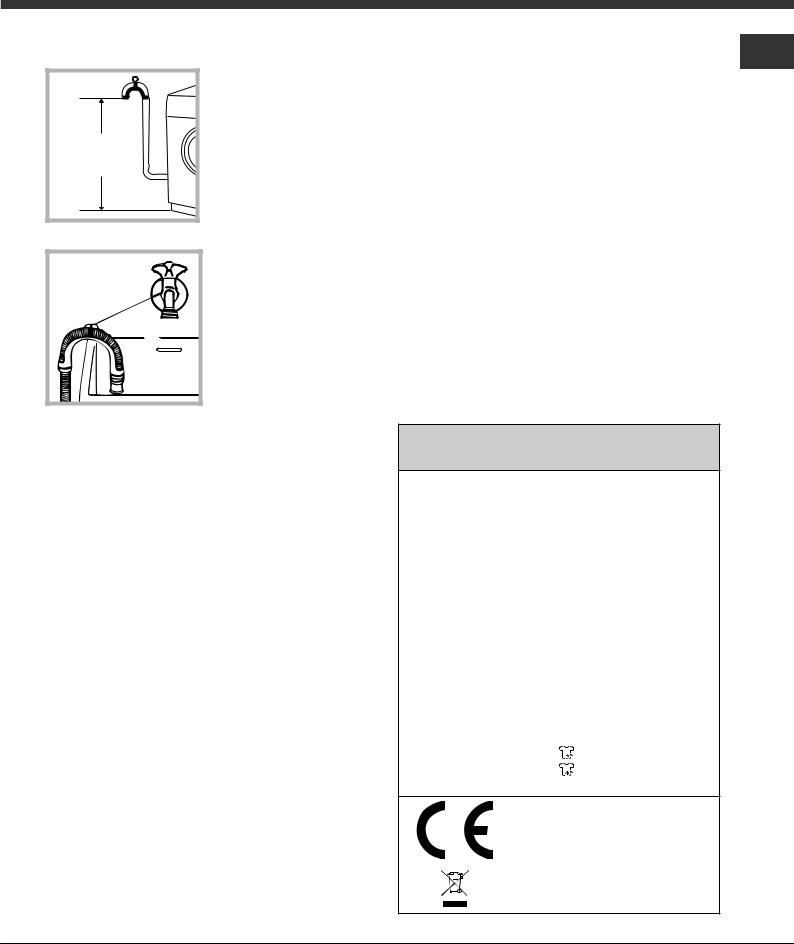
Podłączenie przewodu odpływowego
65 - 100 cm |
Podłączyć rurę odpływową wody do kanalizacji lub otworu spustowego w ścianie umieszczonego na wysokości od 65 cm do 1 m od ziemi, unikając zginania jej.
! Nie używać przedłużaczy ani wtyczek wielokrotnych. |
PL |
|
!Kabel nie powinien być zgięty ani zgnieciony.
!Kabel zasilania elektrycznego oraz wtyczka mogą być wymieniane wyłącznie przez upoważnionych techników.
Uwaga! Producent nie ponosi żadnej odpowiedzialności, jeśli powyższe normy nie będą przestrzegane.
Alternatywnie można oprzeć ją na brzegu zlewu lub wanny, przymocowując do kranu załączony do pralki prowadnik (zobacz rysunek).
Wolny koniec rury odpływowej nie powinien pozostawać zanurzony w wodzie.
! Odradza się używanie rur-przedłużaczy; jeśli przedłużacz jest jednak konieczny, powinien mieć on ten sam przekrój, co rura oryginalna, i nie powinien przekraczać 150 cm długości.
Podłączenie elektryczne
Przed włożeniem wtyczki do gniazdka elektrycznego należy się upewnić, czy:
•gniazdko posiada uziemienie i jest zgodne z obowiązującymi przepisami;
•gniazdko jest w stanie wytrzymać maksymalne obciążenie mocy urządzenia, wskazane w tabeli Danych technicznych (patrz obok);
•napięcie zasilania mieści się w wartościach wskazanych w tabeli Danych technicznych (patrz obok);
•gniazdko jest kompatybilne z wtyczką urządzenia. W przeciwnym razie należy wymienić gniazdko lub wtyczkę.
!Nie należy instalować pralki na otwartym powietrzu, nawet jeśli miejsce to jest chronione daszkiem, gdyż wystawienie urządzenia na działanie deszczu i burz jest bardzo niebezpieczne.
!Po zainstalowaniu urządzenia gniazdko elektryczne powinno być łatwo dostępne.
Danetechniczne
Model |
AQS63F 29 |
|
|
|
|
||
Wymiary |
szerokość cm 59,5 |
||
wysokość cm 85 |
|||
|
głêbokość cm 44,5 |
||
Pojemność |
od 1 do 6 kg |
||
|
|
||
Dane prądu |
dane techniczne umieszczone są na |
||
elektrycznego |
tabliczce na maszynie |
||
|
|
||
Dane sieci |
Maksymalne ciśnienie 1 MPa (10 barów) |
||
ciśnienie minimalne 0,05 MPa (0,5 barów) |
|||
wodociągowej |
|||
pojemność bębna 48 litrów |
|||
|
|||
|
|
|
|
Szybkość |
do 1200 obrotów na minutę |
||
wirowania |
|||
|
|
||
Programy testowe |
|
|
|
zgodnie z dyrekt- |
program |
; temperatura 60°C; |
|
ywami 1061/2010 i |
program |
; temperatura 40°C. |
|
1015/2010 |
|
|
|
Urządzenie to zostało wyprodukowane zgodnie z następującymi przepisami CE:
-2004/108/CE (o Kompatybilności Elektromagnetycznej)
-2002/96/CE
- 2006/95/CE (o Niskim Napięciu)
15
